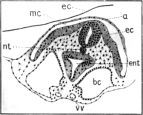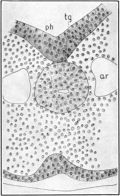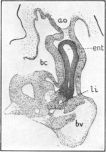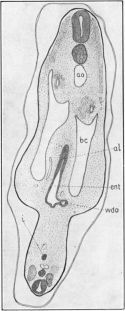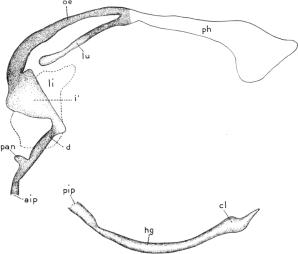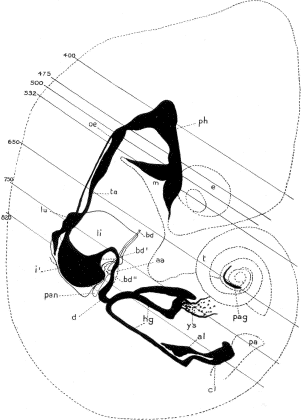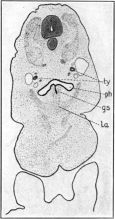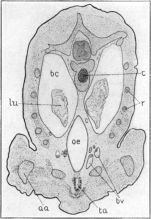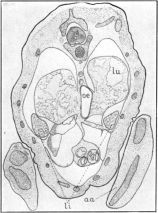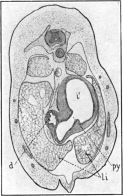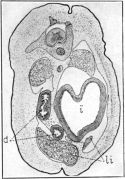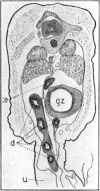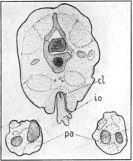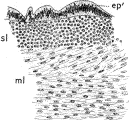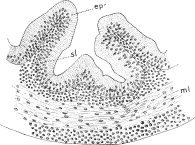SMITHSONIAN MISCELLANEOUS COLLECTIONS
VOLUME 56 NUMBER 11
DEVELOPMENT OF THE DIGESTIVE
CANAL OF THE AMERICAN
ALLIGATOR
WITH FIFTEEN PLATES
BY
ALBERT M. REESE
Professor of Zoology, West Virginia University

(Publication 1946)
CITY OF WASHINGTON
PUBLISHED BY THE SMITHSONIAN INSTITUTION
1910
The Lord Baltimore Press
BALTIMORE, MD., U. S. A.
1
DEVELOPMENT OF THE DIGESTIVE CANAL OF THE AMERICAN ALLIGATOR
By ALBERT M. REESE
Professor of Zoology, West Virginia University
In a previous paper (6) the writer described the general features in the development of the American Alligator; and in other papers special features were taken up in more detail.
In the present paper the development of the enteron is described in detail, but the derivatives of the digestive tract (liver, pancreas, lungs, etc.) are mentioned only incidentally; the development of these latter structures may be described in a later paper.
No detailed description of the histological changes taking place during development has been attempted, though a brief description of the histology is given for each stage discussed.
The material upon which this work was done is the same as that used for the preceding researches. It was collected by the author in central Florida and southern Georgia by means of a grant from the Smithsonian Institution, for which assistance acknowledgment is herewith gratefully made.
Various methods of fixation were employed in preserving the material. In practically all cases the embryos were stained in toto with Borax Carmine and on the slide with Lyon's Blue. Transverse, sagittal, and horizontal sections were cut, their thickness varying from five to thirty microns, depending upon the size of the embryos.
The first indication of the formation of the enteron is seen in the very early embryo shown, from the dorsal aspect, in figure 1. The medullary folds and notochord are evident at this stage, but no mesoblastic somites are to be seen.
A sagittal section of approximately this stage, shown in figure 1A, represents the foregut, fg, as a shallow enclosure of the anterior region of the entoderm, while the wide blastopore, blp, connects the region of the hindgut with the exterior. No sign of a tail fold being present, there is, of course, no real hindgut. The entoderm, which has the appearance of being thickened because of the fact that the notochord has not yet completely separated from it, is continuous, through the blastopore, with the ectoderm. Posterior to the blastopore 2 the primitive streak, ps, is seen as a collection of scattered cells between the ectoderm and the entoderm, apparently formed by proliferation from the ventral side of the ectoderm.
A slightly later stage is shown in figure 2, a dorsal view of an embryo with five pairs of mesoblastic somites. A sagittal section of this stage is shown in figure 2A. The foregut is here more inclosed, and the notochord, nt, having separated from the entoderm, en, is seen as a distinct layer of cells extending from the foregut to the blastopore.
A transverse section through the headfold of this stage is shown in figure 2B. The foregut is seen as a wide cavity, ent, depressed dorsally, apparently, by the formation of the medullary groove and the notochord; it is wider laterally than in a dorso-ventral direction, and its walls are made up of about three layers of closely arranged, irregular cells; the wall is somewhat thinner on the dorsal side, just below the notochord.
Figure 3 is a dorsal view of the next stage to be described; about fifteen pairs of somites are present.
Figure 3A is a transverse section through this embryo near the anterior end of the enteron, ent, which cavity, cephalad to this region, is bluntly pointed. As seen in the figure the enteron is here wide from side to side, and is depressed dorso-ventrally except for a wide groove in the ventral wall. This groove is lined with rather more closely arranged cells, and marks the region where the mouth will break through at a somewhat later stage. A short distance caudad to this region the groove disappears and the pharynx is reduced to a shallow slit extending almost to the superficial ectoderm on either side; then the slit-like pharynx becomes suddenly reduced in a lateral and increased in a dorso-ventral direction, to assume the outline shown in figures 3B and 3C. At a point about one-third of the length of the embryo from the tip of the head, the enteron opens to the yolk-sac, so that what now may be called the foregut has this considerable extent. There is, however, not the slightest indication of a tail-fold, so that there is no inclosed hindgut at all. As is shown in figure 3D, the neurenteric canal, nc, still opens ventrally, though the medullary canal, mc, has now no dorsal opening to the exterior. The medullary canal continues for a short distance (about fifteen sections of five microns thickness) posterior to the opening of the neurenteric canal.
Figure 4 is a surface view of the next stage to be described. There are here about twenty pairs of somites, though the exact number cannot be determined. Although not visible externally in the surface view shown, the gill clefts are beginning to form, and the first one opens to the exterior as will be seen in sections of another embryo 3 of this stage. The mouth has now broken through, putting the wide pharynx into communication with the exterior; probably the mouth opening is formed at about the time of the opening of the first gill cleft.
Figure 4A represents a transverse section through the head of an embryo of the approximate age of the one just described; it passes through both forebrain, fb, and hindbrain, hb; through the extreme edge of the optic vesicles, ov, and through the anterior end of the notochord, nt. It is just cephalad to the anterior end of the pharynx and to the hypophysis. The chief purpose in showing this section is to represent the two large head-cavities, hc. The origin of these cavities may be discussed at a later time. They are irregularly oval in cross section, and extend in an antero-posterior direction for a distance about equal to their long axis as seen in cross section. The two cavities project towards each other in the middle line, and are almost in contact with the notochord, in the region figured, but they do not fuse at any point. These two head-cavities are the only ones to be seen, in this animal, unless the small evaginations from their walls represent other cavities fused with these. Their walls are thin but distinct, and consist of a single layer of cells. These cells are completely filled with their large, round nuclei, so that the wall has the appearance, under higher magnification than is used in this figure, of a band of closely strung, round beads.
Figure 4B represents the eighteenth section caudad to the one just described. It passes through that region of the enteron, ph, which may be called the pre-oral gut, since it lies cephalad to the now open mouth. Owing to the plane of the section the upper angle of the first gill cleft, g1, is seen on the left, although this would not naturally have been expected in a section through the pre-oral gut. The evagination to form the hypophysis, p, is seen against the floor of the forebrain, fb. The wall of this region of the enteron is comparatively thin, and consists of not more than two layers of compactly arranged cells with round nuclei.
Figure 4C is about forty sections caudad to the one just described. It passes through the mouth, seen as a vertical opening between the two mandibular arches, md. The hyomandibular cleft, g1, the only one which opens to the exterior in this embryo, is very wide, and may be traced through a number of sections; in this section the opening is seen only on the left. The pharynx, ph, is very wide; as it is followed caudad its ventral opening is gradually closed by the approach of the two mandibular folds. The dorsal wall of this region of the pharynx is very thin, consisting of a single layer of flat cells with round nuclei; while the ventral wall, leading through 4 the mouth and lining the mandibular folds, is composed of two or three layers of compactly arranged cells.
Figure 4D is through a plane sixteen sections caudad to the last. In this region, which is just caudad to the otic vesicles, the pharynx has still its rectangular outline, and its walls are of the same character as in the preceding figure. The posterior edges of the hyomandibular clefts are seen projecting in a ventro-lateral direction, g1; while dorsal to these are the wider, second pair of clefts, g2. Where the mandibular folds come together posterior to the mouth, they fuse first at their outer or ventral border, which leaves a deep, narrow groove in the anterior floor of the mouth. As this groove is followed caudad its ventral wall is seen to become much thickened, tg, to form the anlage of the thyroid gland. In the present section the walls of the groove are just fusing, to cut off the cavity of the gland from the dorsal part of the groove. The next section caudad to this shows the thyroid as a round, compact mass of cells, with a very small lumen, still closely fused with the bottom of the oral groove. The lumen may, in this embryo, be traced for only a few sections, caudad to which the thyroid is seen as a small, solid mass of cells unattached to the oral groove. Close to the sides of the thyroid are seen two large blood vessels, ar, the mandibular arches, which unite into the single ventral aorta just caudad to the posterior end of the thyroid. High power drawings of the thyroid just described are shown in figures 4E and 4F.
Figure 4G is about fifty-five sections caudad to the preceding figure, and passes through the middle region of the heart, ht. The enteron, ent, is cut caudad to the last gill cleft, but it is nearly as large as in the pharyngeal region described above; its walls are of a more even thickness than in the more anterior sections, though there is an area, just below the aorta, where the wall is still but one cell thick. In the ventral wall of this part of the enteron, and, to some extent, in the lateral walls, there seems to be a tendency for the nuclei to become collected toward the side of the wall away from the digestive cavity; this condition cannot be well seen in the figure owing to the amount of reduction in reproduction.
Figure 4H is seventy-nine sections posterior to the last, and passes through the foregut, ent, just cephalad to the anterior intestinal portal and caudad to the heart. The outline of the enteron is here almost a vertical slit, and the lining entoderm consists, in its dorsal and lateral regions, of a single layer of columnar epithelium, while in its ventral region, where it adjoins the liver trabeculae, it is made up of several layers of cuboidal or irregular cells. The nuclei in the dorsal and lateral regions of the entoderm are arranged in a very definite layer 5 at the basal ends of the cells, though an occasional nucleus may be seen near the center of the layer. The mesoderm that extends ventrad from the mesentery, on each side of the entoderm just described, consists of a thick layer of compactly arranged cells. The ventral end of the entodermal wall is fused with the wall of a small cavity, li, which may be traced several sections cephalad to this plane. This cavity is a part of the system of hollow liver trabeculae seen as a group of irregular masses of cells ventrad to the enteron at the opening of the anterior intestinal portal. The large blood vessel, bv, is the meatus venosus.
Figure 4I is just four sections caudad to the preceding. It passes through the anterior intestinal portal, aip. The medial liver trabecula into which the enteron was seen to open, in the preceding figure, now opens ventrally to the yolk-sac as the anterior intestinal portal. A few liver trabeculae are to be seen on either side of the portal, but they show no lumena, and may be traced through only a few sections. The extent of this uninclosed region, the midgut, is very difficult to determine with accuracy, but, at this stage, it comprises about one-half of all the sections of the series. The difficulty is due partly to the unavoidable tearing of the tissues in removing the embryo from the yolk-sac, and partly to the indefiniteness of the posterior intestinal portal, where the walls of the enteron are very thin. As seen in figure 4I the location of the anterior intestinal portal is very distinct.
A short distance caudad to the anterior intestinal portal there is constricted off from the roof of the midgut a narrow diverticulum, figure 4J, i, the meaning of which is not apparent; it extends through only ten to fifteen sections, tapering caudad till it disappears. The region of the hindgut, at this stage, is about one-fifth of the entire length of the embryo. Its anterior portion is wide and, as has been said, rather indefinite in outline.
Figure 4K represents a typical section through the midgut region of an embryo of about the age of the one from which the preceding figures were drawn. This and the following figures of this stage were drawn from an embryo in which the posterior region was in better condition than in the embryo from which the other figures of the stage were taken. The mesentery, ms, is here of considerable length and continues around the yolk in a layer of diminishing thickness. The epithelium of this region of the enteron consists of a single layer of fairly regular cells, which are columnar in the dorsal region, just beneath the mesentery, and cuboidal or even flattened in regions more distant from the median plane.
Figure 4L, through the region of the hindgut, shows at i the completely inclosed intestine; it is a comparatively narrow tube, lined 6 with columnar epithelium outside of which is a dense layer of mesoblast continuous with the mesentery. In the center of the figure the allantois, al, is seen as an irregular cavity, lined with a single layer of columnar or cuboidal cells, and surrounded by a thick mass of loosely arranged, stellate mesoblast cells. The allantois is probably somewhat larger here than in the other embryos used for this stage, in which it was torn away. The tail, t, of the embryo is shown at the lower side of the figure, surrounded by the amnion; it is cut in the region of a curve so that the caudal intestine, i, is cut longitudinally and has the outline of an elongated ellipse. In this embryo the caudal intestine could be followed to the end of the tail, through several dozen sections; for some distance posterior to the allantois it is extremely narrow, so that its lumen is almost obliterated, and its walls are made up, in any one place, of not more than a dozen cuboidal cells. Towards the posterior end of this region the intestine is considerably enlarged as seen in figure 4L.
Figure 4M passes through the region where both the allantois and the Wolffian ducts open into the hindgut. The union of the allantois and the gut accounts for the elongated outline of the enteron in this section. The openings of the Wolffian ducts, wdo, are seen at the lower end of the section of the enteron. The cells lining the Wolffian ducts are smaller than those lining the enteron. In the lower side of the figure are seen the structures of the tail, including the outline of the tiny caudal intestine, i, mentioned above. No sign of a cloacal invagination could be made out with certainty.
The next stage to be studied is shown in surface view in figure 5.
Figure 5A represents a section through the head region of this embryo. Owing to the obliquity of the plane of the section the figure is quite asymmetrical. The pharynx, ph, is lined with a comparatively thin epithelium and opens, on the left, at two places, one the mouth and the other the second gill cleft, g2. In the dorsal wall of this cleft, as well as in the corresponding wall of the opposite cleft, is seen a thickening of the epithelium; these thickenings, ty, are the rudiments of the thymus gland, whose development may be described in detail in another paper. Compared to the size of the gill clefts the cavity of the pharynx is, at this stage, comparatively small.
Followed caudad the pharynx becomes depressed until, in the region shown in figure 5B, it is a mere narrow slit, g, extending transversely across the embryo and opening through the gill clefts to the exterior on each side.
Figure 5C passes through the posterior region of the pharynx, ph, the tip of the forebrain, fb, the anterior edge of the heart, ht, and the curve of the tail, t. The chief point of interest in this section is 7 the thyroid gland, tg. It now lies deep in the tissue of the floor of the pharynx, entirely separated from the pharyngeal epithelium. It consists of a compact mass of cells, now showing a bilobed structure in its anterior end, and extending through about twenty-five ten-micron sections. It is solid throughout most of its extent, but, in the section figured, which is near the anterior end, the lobe on the right side shows a small but distinct cavity scarcely visible in the figure.
Caudad to the region just described the pharynx contracts suddenly to form the oesophagus, a narrow, V-shaped slit, which soon divides into an upper and a lower cylindrical tube, figure 5D, ent.
Followed caudad the lower of these tubes divides into the two bronchial rudiments, figure 5E, lu, which, in the embryo here figured, extend through nearly one hundred sections. In the region shown in figure 5E the three tubes, oe and lu, lie at the angles of an imaginary equilateral triangle, while in the region of the liver, where the bronchial rudiments end, the tubes lie in the same horizontal plane.
A short distance caudad to the ends of the bronchial rudiments the oesophagus turns suddenly ventrad and becomes much enlarged to form the stomach, figure 5F, i´, which may be traced through twenty-five or thirty sections in this series. The epithelium of the stomach is fairly thick, and consists of five or six layers of compact, indistinctly outlined cells with spherical nuclei. Ventrad to the stomach is seen, in figure 5F a section of the duodenum, i, which extends, with gradually diminishing caliber, for twenty-five or thirty sections caudad to the posterior limit of the stomach, where it opens to the yolk-sac and is lost.
The section that cut this embryo in the posterior region of the stomach also passed through the hindgut in the region of the posterior appendages, figure 5G. There the intestine, i, is a distinct, cylindrical tube which extends, with not much variation in caliber, and with little variation in position, from this point to the cloaca. Followed cephalad, towards the posterior intestinal portal, it gradually diminishes in caliber, as did the foregut on approaching the anterior intestinal portal. The epithelium consists here of three or four layers of compactly arranged cells, and has about the same appearance as in the oesophagus and duodenum.
Figure 5H represents a section through the cloacal region, cl, showing the openings into the cloaca of the Wolffian ducts, wdo. Just anterior to these openings the cloaca opens ventrally into a small, anteriorly-projecting pouch, the rudiment of the allantois.
Caudad to the openings of the Wolffian ducts the cloaca extends 8 ventrad as a narrow, solid tongue of epithelium towards the exterior, figure 5I, and fuses with the superficial ectoderm at the caudal end of a prominent ridge that lies in the mid-ventral line between the posterior appendages. In this embryo the cloaca has no actual opening to the exterior; the walls of the part that projects towards the exterior are in close contact, except in the region of the openings of the Wolffian ducts, as is shown in figure 5H.
Owing to the coiling of the end of the long tail the plane of the section, as is seen in figure 5I, passes through the posterior end of the embryo no less than four times. In the most posterior of these four sections of the tail, beginning slightly caudad to the section here shown, is seen a small cavity which may be called the post-anal gut, pag. It has thick walls, and extends for about thirty-five sections in the series under discussion. Its lumen is very large in its caudal region, figure 5I, pag, and tapers gradually cephalad until it disappears. Posteriorly the post-anal gut ends quite abruptly not very far from the extreme tip of the tail.
Figure 5J is a composite drawing from reconstructions of the enterons of two embryos of approximately this stage. One of these reconstructions was plotted on paper from a series of transverse sections; the other was made in wax from a series of sagittal sections. For the sake of simplicity the gill clefts are not represented, and the pharynx, mouth, and liver are represented in outline only. For the same reason the lung rudiment of one side only is shown.
The relative size of the pharynx, ph, as seen in the figure, is smaller than it is in reality because of the small dorso-ventral diameter (the only one here shown) compared to the lateral diameter. The end of the lung rudiment, lu, is slightly enlarged and lies in a plane nearer to the observer than that of the oesophagus, oe, though this is not well shown in the figure.
The oesophagus, oe, diminishes slightly in caliber for a short distance caudad to the origin of the lungs, then gradually increases in caliber until it suddenly bends to the side (towards the observer) and merges into the wide stomach, i´. The stomach, which is irregularly conical in shape, lies in a place slightly nearer the observer than the end of the lung rudiment mentioned above.
Lying to one side of the stomach and duodenum, and extending cephalad beyond the end of the lung rudiment is the liver, li, whose outline is only roughly shown here by the broken line. The stomach opens rather abruptly into the duodenum, d, which slopes back towards the plane of the oesophagus (away from the observer).
The projection from the side of the duodenum, pan, not well figured here, indicates the position of the pancreas, better shown in 9 the next reconstruction. The duodenum extends only a short distance caudad to this point and then opens, aip, to the yolk-sac.
The yolk-stalk, or unclosed region of the enteron, is still of considerable extent, though its exact boundaries are not easy to determine. The distance between the anterior and posterior intestinal portals is approximately shown in the figure under discussion.
The hindgut is cylindrical in cross section and of about the same diameter throughout, except for a slight enlargement in the cloacal region.
The post-anal gut is not shown here; it will be described in connection with the next reconstruction where it is figured.
Figure 6 is a surface view in profile of an embryo of the next stage to be studied. The manus and pes are here well developed, and the general development of the embryo is in considerable advancement over the last stage studied.
Figure 6A represents a reconstruction, from a series of transverse sections, of the enteron of an embryo of about the age of the one shown in figure 6. The outlines of the entire embryo, of the eye, e, and of the anterior, aa, and posterior, pa, appendages are shown by broken lines. Its position being coincident with that of the stomach, liver, and pancreas, the anterior appendage can scarcely be seen. The enteron, including one lung only, for the sake of simplicity, is shaded solid black, while the liver and pancreas, with their ducts, are outlines with unbroken lines. As in the preceding reconstruction no attempt is made to show the gill clefts, and only the dorso-ventral profile of the enteron is shown. Caudad to the pharynx, the enteron being more or less cylindrical in section, this profile gives a good idea of its shape, but in the pharyngeal region, where the lateral diameter is so much greater than the dorso-ventral, the reconstruction gives but a poor idea of the size of that part of the enteron.
The widely-open mouth, m, leads, with no line of demarkation, into the pharynx, ph, which is of irregular outline and, as has been said, of much greater lateral than dorso-ventral diameter.
The pharynx becomes gradually constricted to form the oesophagus, oe, a very long and slender structure, which, as will be seen in cross section, is, at this stage, solid for the greater part of its length. As in the case of the pharynx, the lateral diameter of the oesophagus is generally greater than the dorso-ventral diameter.
From the floor of the caudal part of the pharynx is pushed out the trachea, ta. In the reconstruction, especially in the anterior end, the trachea appears several times the diameter of the oesophagus; this is due to the great thickness and indefiniteness of its walls rather than to a greater diameter of its lumen.
10At about the position of the line ta the trachea divides into the two bronchi (only one shown in the figure), which are somewhat enlarged at the ends to form the lung rudiments, lu. While the trachea and bronchi lie ventrad to the oesophagus, the lungs lie laterad and even dorsad to the oesophagus and cardiac end of the stomach. Caudad to the heart and in the region of the anterior appendages, aa, the oesophagus suddenly enlarges to form the stomach, i´, which has now quite the outline of the typical human stomach.
From the stomach the duodenum, d, extends, following a sort of V-shaped course, towards the yolk-stalk, ys. In the region of the yolk-stalk it is somewhat enlarged and ends in a blind sac like a caecum. At the side of this sac is seen the opening of the enteron to the yolk-stalk; the anterior and posterior intestinal portals are not distinguishable from each other. From this point the hindgut, hg, extends cephalad until it lies laterad to the middle region of the duodenum, then bends through 180° and extends, in an almost straight line, to the cloaca, cl, lying in the region of the posterior appendage, pa.
The allantois, al, extends cephalad for some distance from the floor of the cloaca. Some distance caudad to the cloaca, near the end of the much coiled tail, is seen the post-anal gut, pag. This structure as has been noted above, is quite distinct from the other parts of the enteron. It is of elongated, pyriform outline, with the pointed end extending cephalad.
In the narrow space between the stomach and the duodenum is the elongated pancreas, pan, opening by two or more short ducts into the duodenum.
The liver, li, in the figure under discussion, has about twice the area of the stomach. It extends caudad and dorsal about the same distance as the latter organ, but it extends ventrad and cephalad far beyond the boundaries of the stomach.
Extending along the ventral border of the liver is a long narrow duct, apparently the bile duct, bd. It connects, caudally, with the anterior end of the pancreas, while at its other extremity, near the antero-ventral corner of the liver; it ends blindly.
The transverse sections now to be described have been selected from the series from which the reconstruction, just described, was made.
Figure 6B represents a typical section through the pharynx. Its plane is approximately shown by the line 400 of figure 6A though the plane apparently does not cut the eye, e. The pharynx, ph, has here the outline of an irregular V. Its walls, except at the outer 11 angles of the clefts, g1, are composed of but a single layer of cells. In the dorsal wall these cells are flattened, while in the ventral wall they are more rounded. This difference in the shape of the cells accounts for the slightly greater thickness of the floor over that of the roof of the pharynx. The gill clefts no longer communicate with the exterior.
Figure 6C represents the caudal half of the embryo in the plane 475 of figure 6A. The section of the pharynx, ph, is here crescentic in outline, and the pharyngeal walls, especially the floor, are somewhat thicker than in the more anterior section just described. Lying a short distance dorsad to the pharynx are seen two small, thick-walled openings, ty; these are the rudiments of the thymus glands. They are here quite distinct from the enteron, and may be traced through a large number of sections, being in some regions solid and of a smaller diameter than in the present section.
Figure 6D is in the region of the line 500 in figure 6A. The thymus rudiments, ty, have about the same appearance as in the preceding figure, except that they are somewhat larger. The pharynx, ph, is much smaller than in the last section, and though somewhat crescentic in outline, its convex side is dorsal instead of ventral in position. The pharyngeal walls are here thicker, and consist of two or three layers of cells, instead of the single layer of more anterior sections.
In the median plane the floor of the pharynx is pushed down, as a solid tongue of cells, gs, the anterior edge of the glottis. Ventrad and laterad to the glottis a crescentic condensation of mesoblast represents the beginning of the laryngeal cartilages, la.
Two or three sections caudad to the one just described, the two layers of which the tongue of cells from the floor of the pharynx is composed separate slightly at the bottom to form a small cavity, the trachea, ta; this condition is shown in figure 6E, which represents part of a section through the plane 532 of figure 6A.
The oesophagus, oe, is here a solid, crescentic mass of cells, the lumen being completely obliterated. The dorsal part of the tongue of cells, mentioned above, connects the ventral side of the oesophagus with the trachea, like a sort of mesentery. Above the oesophagus, on either side, is the thymus rudiment, ty, in this section practically a solid mass of cells instead of a tube. The epithelium of the trachea here consists of three or four layers of compactly arranged cells; this epithelium is surrounded by a dense mass of mesoblast which is responsible for the greater thickness of the trachea as seen in figure 6A. As has been said, the oesophagus here has no lumen, and when examined under high magnification its walls are found to be completely 12 fused, not merely in close contact. The same is true of the tongue of cells between the oesophagus and trachea. Two or three sections caudad to the one under discussion this tongue of cells loses its connection with the trachea, and the latter structure is entirely independent of the oesophagus.
The solid condition of the oesophagus continues through about fifty sections of this series, the horns of the crescent gradually shortening until only the central part remains as the hollow cylinder seen in figure 6F, oe, which is a section through plane 650 of figure 6A. From about this point to its opening into the stomach the oesophagus has essentially the same structure. Its epithelium is of the simple columnar type, the cells being long, with generally basally located nuclei.
In the section under discussion the trachea, ta, is of about the same size as the oesophagus, but its epithelium is thicker and consists of two or three layers of cells. The trachea extends, as a separate and distinct structure, through about one hundred and fifteen sections, and then, at a point four or five sections caudad to the present section, it divides suddenly into the two bronchial tubes. Each bronchus, like the trachea, is lined with an epithelium of three or four layers of cells; but the epithelium is surrounded by a thin layer of much condensed mesoblast. The bronchi continue caudad, with slightly increasing caliber, through about fifty sections, when they suddenly enlarge to form the lungs. As seen in figure 6A the lungs are irregularly conical in outline and lie on either side of the posterior end of the oesophagus.
Figure 6G is a section through the plane 750 of figure 6A. The oesophagus, oe, is seen as a small, circular opening between two much larger openings, the lungs, lu. The epithelium of the oesophagus is the same here as in the more anterior regions described above; that of the lung rudiments is very variable in thickness, even in different parts of the same section, being in some places composed of a single layer of cuboidal or even flattened cells, in other places consisting of four or five layers of cells (not well shown in the figure). Surrounding the epithelium of the lung rudiments is a thin layer of quite dense mesoblastic tissue. A fairly well defined mesentery, ms, is now present in this region.
Filling the greater part of the body cavity, below the oesophagus and lung rudiments, is the liver, li; and ventrad to the liver the section passes through a loop of the duodenum, d.
The epithelium of the duodenum consists of four or five layers of compactly arranged cells, near the center of an oval mass of fairly dense mesoblast. In a lateral projection of this mass of mesoblast 13 lies a small, circular opening, the bile duct, bd. Its epithelium consists of a single layer of columnar cells. In more anterior sections the bile duct is larger in cross section, being about one-half the diameter of the oesophagus. As has been said it ends blindly at a point a short distance anterior to the antero-ventral edge of the liver. A few sections caudad to the one under discussion the bile duct connects with the liver, figure 6A, bd´; and some distance caudad to this the duct opens, bd´´, into the duodenum so close to the opening, pan´, of the pancreas that it is difficult to determine whether the latter organ has a separate opening into the duodenum or opens into the bile duct.
At some distance ventrad to the structures just described the intestine is cut, by the plane of the section, in two places, i. The more dorsal of these is inclosed and has, under this magnification, the same appearance as the duodenum, d; a higher magnification, however, shows that its epithelium consists of a single layer of tall, rather clear, columnar cells. The more ventral of the two sections, above mentioned, which is continuous with the dorsal section a very short distance caudad to this point, is in the region that opens to the yolk—in fact a number of yolk-granules, y, may be seen in the opening. The epithelium of this part of the intestine consists of a single layer of clear, columnar cells, which, around the borders of the opening, are thrown into numerous folds and are almost of goblet form.
Figure 6H represents a section through the plane 820 of figure 6A. The section is caudad to one lung and cuts the extreme tip of the other, lu. The liver, li, and pancreas, pan, are seen at the side of the stomach, i´, here cut through its greatest transverse diameter. The epithelium of the stomach varies somewhat in thickness and consists of two or three layers of cells, the variation in thickness being due to a variation in the length of the cells rather than to a variation in the number of layers.
Ventrad to the stomach the intestine, i, is cut in three places, of which the most dorsal section is the largest. The epithelium of these intestinal sections, especially the lower two, consists of usually a single layer of columnar cells which are clearer than those of the stomach. A fairly thin mesentery, ms, supports this region of the intestine.
In the region of the posterior appendages, pa, the section passes through the hindgut, hg, and allantois, al. The former is of about the same size as the more anterior sections of the intestine, but its epithelium is less clear and is composed of two or more layers of cells. The allantois is cut near its opening into the hindgut; its walls 14 are thin, the epithelium consisting of but a single layer of more or less flattened cells.
Figure 7 represents a reconstruction of the enteron of an embryo of 42 mm. crown-rump length. Because of the body flexure and large size of the embryo the head was amputated, in the plane a-b, and cut sagitally, while the body was cut transversely in the direction shown by the section planes. In the present figure the outline of the embryo, including the eye, appendages, and umbilical stalk, is shown by fine dotted lines; the outlines of the lungs and liver are shown by heavier, broken lines; while the outlines of the enteron proper and the trachea are shown in solid lines, filled in which fine stippling. For the sake of simplicity only one lung and one bronchus are shown.
Since the head has now quite a reptilian form, the oral cavity, m, has more or less of the adult outline. A transverse groove near the anterior end of the lower jaw marks off the tongue, tn; and the rudiments of teeth are seen but not shown in the figure because of the low magnification used.
The pharynx, ph, is a very extensive cavity that is sharply separated from the mouth by a prominent transverse fold of skin, the velum palitum, vp, just in front of the posterior nares, pn, and by a less marked fold from the base of the tongue; it is these two valves that enable the adult alligator to open its mouth under the surface without getting water into the lungs. The mouth and pharynx are lined at this stage with a thin, stratified epithelium, which consists of a basal layer of rather tall columnar cells and one or two superficial layers of flattened cells. The pharyngeal epithelium is rather thicker than that of the oral cavity.
In the embryo from which this reconstruction was made the pharynx was in direct communication with neither the oesophagus nor the trachea, though the separation in each case was by a mere membrane. The trachea, ta, opens, except for this membrane, into the pharynx a short distance back of the transverse, dorsal and ventral folds mentioned above, and almost directly ventrad to the posterior nares. The anterior end of the oesophagus, oe, is in contact with the extreme postero-ventral wall of the pharynx.
The trachea, which is already surrounded by distinct cartilaginous rings, is long, and of about the same diameter throughout. In the region of the anterior appendage, at the point marked X, it divides into the two very short bronchi, which almost immediately open into the lungs, lu. The lungs, whose structure will be shown in the sections of this stage, are large, irregular bodies, extending about equal distances cephalad and caudad to their openings into the 15 bronchi. The caudal ends of the lungs overlap the cephalic end of the liver, li.
The oesophagus, oe, is large, and is laterally compressed so that its dorso-ventral diameter, the one shown in the present figure, is two or three times as great as its lateral diameter. This gives the impression, in the reconstruction, that the oesophagus is nearly as large as the stomach.
As has been said, the oesophagus does not open directly into the pharynx, but is separated from it by a membrane which consists of the flattened epithelial layers of both cavities separated by a thin layer of mesoblast. This partition between the pharynx and the oesophagus is not a mere fold of mucous membrane, but is a complete, though thin, wall, easily seen in the series of sagittal sections from which this region of the embryo was drawn. The anterior end of the oesophagus is suddenly constricted so that the actual opening closed by this partition is not large.
Followed caudad the dorso-ventral diameter of the oesophagus varies somewhat, as does the lateral diameter, but it remains large throughout and opens into the stomach with no sharp line of demarkation. The character of the epithelium of the enteron caudad to the pharynx will be discussed in connection with the sections to be described below.
The stomach, i´, is very different in outline from what was seen in the last stage described, figure 6A. Instead of having approximately the form of the typical mammalian stomach it is now so elongated that the opening into the duodenum, the pylorus, py, seems to be nearer the anterior than the posterior end. While the position of the pylorus is very distinct it is difficult to distinguish the line of demarkation between the stomach and the oesophagus.
The extreme caudal region of the stomach is enlarged to form a blind sac, representing the gizzard, gz. A slight enlargement in the region of the pylorus may represent the glandular region of the adult stomach. The stomach opens, in a rather curious way, into the side of the duodenum, d, the anterior end of the latter structure having the appearance of a sort of caecum, to be seen in the next stage of development.
The duodenum, d, makes a U-shaped bend at the side of the stomach, and then, in the region of the caudal edge of the gizzard, gz, dips suddenly ventrad and caudad towards the umbilical cord, u, where it apparently ends blindly, though this appearance is probably due to an artifact in the embryo from which the reconstruction was made. It is likely that, in removing the embryo from the yolk, the connection between the two loops, i, of the intestine was broken.
16The ascending intestinal loop is of slightly less caliber than the descending loop above mentioned; it passes dorsal and cephalad to the posterior border of the gizzard where its lumen is continuous, for a short distance, with that of the descending loop above described. This unusual condition is probably abnormal, but owing to lack of material only one series of this stage was studied.
At the dorso-caudal angle of the gizzard the small intestine, i, opens into the ventral side of a larger tube which may be called the large intestine, il. The blind end of the large intestine, cephalad to the opening of the small intestine, projects forward, dorsal to the gizzard, as a sort of caecum, ce, though this structure is generally stated to be wanting in the crocodilia, and is not seen in the next stage.
From the caecum the large intestine passes in a ventro-caudal direction, with gradually decreasing caliber, to the cloaca, from whose anterior wall the intromittent organ, io, projects.
From the ventral wall of the large intestine, at a point about one-third the distance from the cloaca to the caecum, projects ventrad and cephalad the stalk of the allantois, al. Owing to its thin walls and small lumen the allantois was traced only a short distance into the umbilical stalk.
The profile of the liver, li, has, at this stage, about the same area and even outline as that of the lung. It lies, of course, on both sides of the enteron proper, and overlaps, anteriorly, as has been said, the posterior end of the lung.
Figure 7A represents a section through the plane 305 of figure 7. A considerable advance in the general development of the organs is seen over the last stage studied. The spinal column is well outlined in cartilage, and the ribs are cut at various places, r. In the body wall a considerable differentiation of muscular tissue has taken place, but it is only faintly shown in this series of figures. The scales, especially along the mid-dorsal line, are shown as an area of less closely dotted tissue.
The lungs, lu, cut here through their anterior ends, are large, but do not nearly fill the cavities, bc, in which they lie; they have the sacculated appearance characteristic of embryonic lung tissue.
The oesophagus, oe, is cut through about its middle region, where its caliber is greatest. As was said above, its dorso-ventral diameter is more than twice its lateral diameter, caused partly by the oblique angle at which it was cut. Its wall, figure 7H, is very thin and exhibits a dense layer of mesoblastic tissue, in which circular and longitudinal muscle layers are beginning to differentiate. It is lined by an epithelium which here consists of a single layer of columnar 17 or cuboidal cells with large nuclei. On the ventral side, where the oesophageal wall is in contact with that of the trachea the epithelium is somewhat thickened by an increase in the number of cell layers. With the low magnification used these details could not, of course, be shown.
The trachea, ta, is of much smaller caliber than the oesophagus, especially in its dorso-ventral diameter. While its epithelial lining is not yet appreciably different from that of the oesophagus, its connective tissue wall is much thicker and shows numerous condensations, the rudiments of the cartilaginous rings. In the region represented by this figure the connective tissue layers of the trachea and oesophagus are continuous with each other, but cephalad and caudad to this point they are distinct, though sometimes in contact. Several large blood vessels, bv, on each side of the oesophagus probably represent the carotids and jugulars, but they were not worked out to determine with certainty which they were.
Eighty-five sections (figure 7, X) caudad to the one under discussion the trachea divides into the two bronchi. These bronchi gradually separate from each other until, at the point at which they open into the lungs, about eighty sections caudad to their point of separation, they lie on either side of the ventral third of the oesophagus.
Figure 7B represents a section through the plane 480 of figure 7. The section is just cephalad to the heart, and passes through the caudal third of the lungs, lu, which have the same appearance as in the preceding figure; also through the extreme cephalic end of the liver, li. The lungs here much more nearly fill the body cavity than in the preceding figure. The section being caudad to their openings into the lungs the bronchi do not, of course, show.
The oesophagus, oe, is here of much less diameter than in the preceding figure, but is still laterally compressed. Its wall is somewhat thicker than in the more cephalic region, the increase being mainly due to the greater thickness of the connective tissue layer, though the epithelium is also slightly thicker because of an increase in the length of the lining cells. Instead of lying almost entirely ventrad to the lungs, as in the preceding figure, the oesophagus here lies directly between them.
Figure 7C represents a section through the plane 627 of figure 7. The plane of the section passes through the opening of the stomach, i´, into the duodenum, d. The cross section of the stomach is somewhat larger than that of the oesophagus, but it differs from the more anterior region mainly in the character of its walls. These are much thicker than in the oesophagus; in the mesoblast which 18 forms the greater part of their thickness, muscle fibers are beginning to differentiate. The epithelial layer also is thicker than in the oesophagus; it consists of tall columnar cells that, at places, are thrown into small folds, figure 7I. These folds, even under the low magnification used, are more evident than is shown in the present figure. The pylorus, py, is wide and, as has been noted in connection with figure 7, is situated far cephalad to the caudal end of the stomach. It opens into the side rather than into the end of the duodenum, which projects cephalad as a short blind pouch, d. The stomach and duodenum, in this section, are almost completely surrounded by the liver, li.
Figure 7D represents a section through the plane 680 of figure 7.
The stomach, i´, which is cut through its middle region, is somewhat larger than in the preceding figures, though its walls have about the same character. Its outer walls are continuous, to a considerable extent, with the tissue of the surrounding body wall, especially in the region just caudad to the plane of the present section.
The duodenum, being cut through a double loop (see figure 7), is seen in two places, dorsally where it is cut through the edge of one loop, and ventrally where it is cut square across. In both sections the structure is the same, as might be expected, figure 7J. The surrounding mesoblast is differentiated into muscle fibers, figure 7J, ml, which form a fairly distinct layer; inside of this layer is a tall columnar epithelium, ep´, which is thrown into prominent folds. A thin layer of mesoblast, probably the submucosa, sl, lies beneath the epithelium and projects up into the folds. About ten or twelve folds are seen in any one section; only the larger ones are well seen in figure 7D.
Figure 7E shows a section through the plane 770 of figure 7. It is in the region of the umbilicus, u, and the extreme caudal end of the stomach which has been called the gizzard, gz. The small size of the gizzard is due to its being cut near its caudal margin. The enteron is here cut in no less than seven places: the reason for this will be evident on examination of the plane of the section as shown in figure 7. Dorsal to the gizzard the section cuts the so-called caecum, ce, a little nearer its anterior end than is shown in figure 7. The duodenum, d, is cut at five points, and has about the same structure as in the preceding figure. The character of the duodenal loops that causes the rather curious appearance of the present figure will be readily understood by reference to figure 7, though the reconstruction is not mathematically accurate. The ventral projection of the lower loops of the duodenum into the umbilicus is seen both in the present figure and in the reconstruction. The loop of 19 the duodenum that, in the sections, is seen to lie directly ventrad to the gizzard, in the reconstruction is shown too much to the side of the latter organ. The descending loops of the duodenum are cut in such a way that the surrounding mesoblast forms a continuous mass of tissue.
Figure 7F represents a section through the plane 901 of figure 7. The section passes through the kidneys, k, the edge of one posterior appendage, pa, the large intestine, il, and two regions of the small intestine, i.
The large intestine is here a thick walled, cylindrical structure, il, hanging from a thin mesentery, ms, in the much reduced body cavity. The layers of its wall are much more fully differentiated than in the more anterior regions of the enteron. The epithelium is here stratified instead of simple columnar, and the folds into which it is thrown are broader and less numerous than in the duodenum above described.
Ventrad to the large intestine, and almost in contact with it, is seen the allantois, al, whose general outline was noted in connection with figure 7. It is an irregular structure, consisting of a very thin outer layer of mesoderm, lined with a single layer of flattened epithelial cells.
Lying at a considerable distance ventrad to the main body of the section, are seen the two sections of the small intestine, i, surrounded by irregular strands of tissue from the umbilicus. The structure of these two intestinal loops is about the same as in the more anterior region described above.
Figure 7G, the last of this series, represents a section through the cloaca, caudad to the urinary openings, in the plane 1060 of figure 7. The epithelium of the cloaca is, of course, simply a continuation of that of the surface of the body, somewhat thickened, perhaps, in the deeper regions.
The intromittent organ, io, which projects cephalad from the wall of the cloaca, is here seen as a three-pointed body of considerable size, projecting ventrally from the body.
Figure 8 shows in outline the enteron, from the ventral aspect, of an embryo of 20 cm. total length, or at about the time of hatching. The drawing was made from a dissection and, for the sake of simplicity, only the enteron, respiratory organs, heart, and thymus are shown. The jaw is cut through on the left side and is turned over to the right, thus bringing into view the roof of the mouth, m, and the dorsal side of the tongue, tn. At the same time the pharynx, ph, and the wide anterior end of the oesophagus, oe, are cut open, exposing the glottis, gs, and vocal cords, vc.
20The lungs, lu, and trachea, ta, which are now fully formed, are dissected loose and drawn over to the right side of the animal, together with the heart, ht, and the thymus, ty; only one side of the thymus is shown, the other half being hidden by the trachea.
The mouth has reached nearly the outline of the adult. The lips are formed and, in the anterior part of the lower jaw, four tooth rudiments, to, are externally visible. The mucous membrane of the roof of the mouth, m, is covered with rounded papillae, easily seen with a lens but not shown in the figure. The tongue, tn, is fully formed, and is free anteriorly and laterally to about the extent that is seen in the adult; the papillae with which it is covered are not so prominent as those seen on the roof of the mouth. At the base of the tongue is the prominent transverse fold, noted in connection with figure 7, that meets above the velum palitinum, not shown here but shown in figure 7. Caudad to these folds is seen the glottis, gs, a triangular opening with the vocal cords, vc, at its base.
The mucosa of the inside of the pharynx and the anterior end of the oesophagus, exposed by the dissection, is thrown into numerous longitudinal folds, not shown in the figure; these well-marked folds extend throughout the length of the oesophagus.
The oesophagus, oe, tapers gradually from the wide pharynx, ph, and then continues as a cylindrical tube of uniform diameter to the right side of the anterior end of the stomach, where it opens into the latter organ. Its walls are thick, and its lumen is almost obliterated by the longitudinal folds of the mucosa, mentioned above.
The stomach, i´, is oval in outline, though somewhat flattened laterally; it is depressed, dorso-ventrally, to a little more than half the lateral diameter. As has been said, the oesophagus enters its right anterior border; the pylorus is on the right side, 3 or 4 mm. caudad to the oesophageal opening. The wall of the stomach is comparatively thin except in the region of the oesophageal and pyloric apertures, and at a point, opposite these apertures, on the left side. At the latter point is an oval or disc-shaped area that is several times as thick as the surrounding wall; it probably represents the gizzard structure of the adult. The thickening mentioned in the region of the two apertures seems to be mainly due to a wrinkling of the mucosa which, in other parts of the stomach, is nearly smooth, so far as can be seen with the naked eye. A sphincter thickening around the oesophageal and, to some extent, around the pyloric aperture, causes each of these structures to project into the stomach like an ileo-caecal valve.
The pylorus, py, opens into a small, pointed, thin-walled diverticulum, di, and, at the same time, into the duodenum, d. The diverticulum 21 noted, also, in connection with figure 7, has relatively thick, wrinkled walls; its significance is not known to the writer. From this diverticulum the duodenum, d, leads caudad and laterad for a short distance as a narrow tube, then suddenly expands into the widest part of the entire intestine. Into this wide part of the duodenum, 3 or 4 mm. from the pylorus, opens the bile duct, bd. The bile sac, bs, is an elongated oval body with thin walls, lying to the right of the pylorus, its connection with the liver was not seen.
Lying between the anterior end of the duodenum and the posterior end of the stomach, and extending caudad for 10 to 15 mm., in the median plane of the animal is the pancreas, pan. It is a long narrow body of a whitish color; its duct or ducts could not be determined by dissection. The duodenum extends caudad, with gradually diminishing caliber, from the enlarged region mentioned above. About 10 to 15 mm. caudad to the stomach it makes a sort of double loop to the right, a wide loop, lp, and a close one, lp´, nearer the median plane. From the latter loop the intestine extends straight to the left, for a distance of about 10 mm., where it makes a small loop cephalad, lp2, and then opens to the yolk-sac, y. The yolk-sac is shown here simply as an irregular piece of tissue, the yolk having been removed.
The anterior intestinal portal, aip, and posterior intestinal portal, pip, are in close proximity with each other.
From the posterior intestinal portal the intestine extends straight cephalad to the posterior end of the stomach, dorsal to which it forms a double loop, a wider one, lp3, and a narrow one, lp4. From the latter loop, lp4, the intestine extends straight caudad, parallel and near to the straight region leading from the posterior intestinal portal, until it reaches the region of the loop lp2, dorsal to which it forms a small loop, lp5. From loop lp5 the intestine, which is here of very small caliber, extends caudad for about 10 mm., where it forms another indistinctly double loop, lp6.
From loop lp6 the large intestine, il, extends, with gradually increasing caliber, to the cloaca, cl, a distance of 10 to 15 mm.
Except in the enlarged region near the pylorus the lumen of the intestine is almost obliterated by the folding of its thick walls, so that little or nothing can be told of its lining with the naked eye.
A distinct mesentery holds the loops of the intestine in position and binds the entire enteron close to the dorsal body wall. Because of the lack of properly fixed tissue no sections of the enteron of this stage were made.








